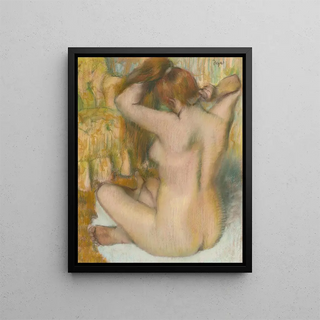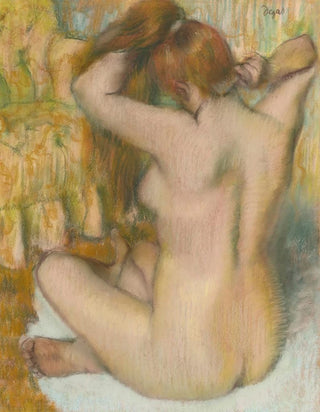Art print | Woman from behind styling her hair woman painting herself - Edgar Degas


View from behind

Frame (optional)
The artwork "Back Nude Woman Styling Her Hair, Woman Painting Herself" by Edgar Degas is a true ode to feminine beauty and the intimacy of everyday gestures. In this piece, Degas manages to capture a fleeting moment, a suspended pause in time, where the woman, absorbed in her act of styling her hair, becomes the focal point of a reflection on sensuality and routine. The model's posture, turned towards the mirror, evokes a palpable intimacy, an invitation to contemplate not only art but also the female condition at the end of the 19th century. The piece transports us to a universe where beauty blends with simplicity, and where each brushstroke seems to tell a personal story.
Style and uniqueness of the work
Degas's style in this artwork is characterized by a subtle blend of realism and impressionism. The contours of the woman are delicately sketched, while the chosen colors reveal a soft and soothing palette. The play of light and shadow gives the scene emotional depth, emphasizing the intensity of the moment. The artist masters the capture of movement perfectly, and every detail, from the reflection in the mirror to the texture of the hair, is treated with meticulous attention. This painting is also an example of Degas's fascination with the female body, which he often depicts in moments of daily life, far from idealized poses. Thus, the work stands out for its ability to transform a banal gesture into a scene imbued with poetry and grace.
The artist and his influence
Edgar Degas, an emblematic figure of the Impressionist movement, knew how to mark his era with stylistic and thematic innovations. Although often associated with representations of dancers and café scenes, his exploration of women's intimate lives, as evidenced by "Back Nude Woman Styling Her Hair, Woman Painting Herself," reveals a rare psychological depth. Degas is interested in the female condition, the fleeting beauty of everyday gestures, and how light and color can evoke emotions. His influence on modern art is undeniable, inspiring many artists to explore

Matte finish

View from behind

Frame (optional)
The artwork "Back Nude Woman Styling Her Hair, Woman Painting Herself" by Edgar Degas is a true ode to feminine beauty and the intimacy of everyday gestures. In this piece, Degas manages to capture a fleeting moment, a suspended pause in time, where the woman, absorbed in her act of styling her hair, becomes the focal point of a reflection on sensuality and routine. The model's posture, turned towards the mirror, evokes a palpable intimacy, an invitation to contemplate not only art but also the female condition at the end of the 19th century. The piece transports us to a universe where beauty blends with simplicity, and where each brushstroke seems to tell a personal story.
Style and uniqueness of the work
Degas's style in this artwork is characterized by a subtle blend of realism and impressionism. The contours of the woman are delicately sketched, while the chosen colors reveal a soft and soothing palette. The play of light and shadow gives the scene emotional depth, emphasizing the intensity of the moment. The artist masters the capture of movement perfectly, and every detail, from the reflection in the mirror to the texture of the hair, is treated with meticulous attention. This painting is also an example of Degas's fascination with the female body, which he often depicts in moments of daily life, far from idealized poses. Thus, the work stands out for its ability to transform a banal gesture into a scene imbued with poetry and grace.
The artist and his influence
Edgar Degas, an emblematic figure of the Impressionist movement, knew how to mark his era with stylistic and thematic innovations. Although often associated with representations of dancers and café scenes, his exploration of women's intimate lives, as evidenced by "Back Nude Woman Styling Her Hair, Woman Painting Herself," reveals a rare psychological depth. Degas is interested in the female condition, the fleeting beauty of everyday gestures, and how light and color can evoke emotions. His influence on modern art is undeniable, inspiring many artists to explore






